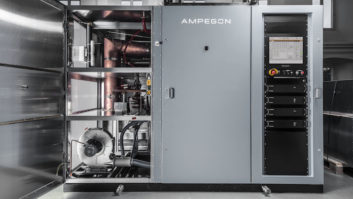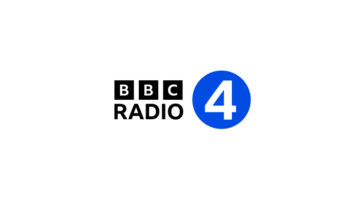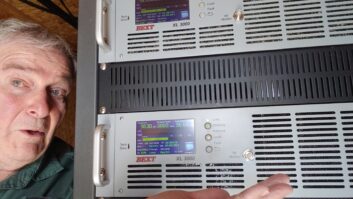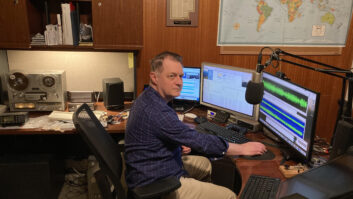The author is chairman of Digital Radio Mondiale.
Is medium wave in decline? Some people think so.
In the 1950s radio was declared mortally wounded by TV. But then FM with its new music rescued it, becoming one of the most successful technologies and platforms ever. Radio survived and thrived but AM should have died at the hands of the nimbler, younger and more attractive FM.

Only it did not and the medium reinvented itself by using presenter-led programming, commercial music and sport. In the United States it took until the end of 1990s for the FM and AM audiences to be equal and to this day the big AM stations are going strong, bringing in the ad dollars.
REASONS
Still, it’s undeniable that the whiff of decline has enveloped AM in the past two decades. The reasons are well-known: Analog medium wave doesn’t always deliver the best sound, it can suffer from interference, it can behave annoyingly different by day and night and even by season. Medium wave mainly appeals to a maturing population (a global phenomenon, considered shameful by some!) using aging receivers (this is bad!).
Analog medium-wave broadcasting also needs quite an infrastructure and deep pockets for the electricity bill.

On the other hand, medium wave is that middle sister that delivers by giving excellent regional coverage over hundreds or (overnight and if the ionosphere behaves) even thousands of kilometers, whereas FM goes up to roughly 200 kilometers and digital DAB+ to half of that.
Medium wave is not only a regional but also an excellent local coverage solution. In Australia 33% of the public broadcaster ABC’s local transmitters broadcast in AM and 11 50 kW transmitters are serving the mainland capital or big cities. Medium wave covers large areas and reaches small far-flung communities for whom, even in developed countries, medium wave and FM still provide the first source of information.
Besides, medium wave with its reach, availability outdoors and on the go, is a fallback solution in times of emergency or simply a good standby solution when other platforms or services are unavailable (broadband, satellite, 4G or the mythical 5G).
The listeners’ behavior and the demands of the digital world are such that tackling medium wave has elicited different responses from broadcasters and regulators worldwide. In Europe, where the frequency was much used and abused, broadcasters initially energized by the potential of IP have not thought twice about closing down many medium-wave transmitters. Some have survived the cull, for example, in the UK, France, Spain, or in some eastern European countries.
DIFFERENT SCENARIOS
Regulators in other parts of the world have embraced different scenarios. One was to migrate AM to FM, or AM to a digital solution for FM (HD or DAB+). This process has taken a long time and, despite some successes, has shown it’s no replacement for AM or for a full large regional or national coverage.
In other parts of the world, like Brazil, digital was not even part of the mix. The simple migration AM to FM is plodding on there, as this is easier done in smaller places than in bigger, overpopulated ones, like big cities where there is no FM spectrum available and where the original demand for a solution came from.
Another idea is to expand the FM band, downwards, migrate everyone and forget about AM altogether, as FM seems a proven and winning formula. A nice idea but then, on top of the costs of replacing a large area covering transmitter with many, expensive, spectrum and energy hungry FM transmitters, there is the extra challenge of the new receivers to be produced and actually sold.
Certainly, there is also the option of doing nothing. Reading through the most recent submissions to the judicious consultation launched by the Australian regulator on the future delivery of radio services, I was struck by how some contributors claim that there is no current replacement for analog AM. Their scenario is to leave things as they are, for at least the next 10 years.
[Read: Historic Woofferton Boasts a Modern Twist]
Change is though the name of the radio game. While analog AM will subsist, it is worth looking at other options, too. In India where most of the territory and population are covered by the public radio medium-wave transmitter infrastructure, the government and public broadcaster took the bull by the horns and deployed almost 40 digital transmitters covering about half the country population with a digital signal.
THE SOLUTION
Recently cricket fans were able to enjoy an open-air demonstration of three different DRM programs on one frequency ahead of an important match in Bangalore. The fans also received data (stock exchange values) available on radio screens. This demonstrated that digital DRM is a game changer for medium wave.
In DRM the crackling audio disappears as sound is as good of that on FM. The electricity consumption and costs decrease, the spectrum is trebled and reception, even in cars (as available in over 1.5 million cars in India currently) is excellent, too.
If it is so good then why isn’t DRM medium wave conquering the world faster? Maybe it’s about confidence in a new platform. Broadcasters and governments need to market DRM digital radio once signals are on air in their countries.
As for receiver availability and their costs, let us remember how many receivers were on sale in the 1970s when FM was taking over the world. Nowadays, many listeners consume radio in their cars rather than sit in front of a retro looking wooden box. Digital receivers (DRM alone or DRM/DAB+) are a reality and a bigger push for digital would help with volumes sold thus bringing down the prices.
Radio, and therefore medium wave, can and should survive digitally. Digital radio must be an enabler of audio content and information while preserving its ubiquitous and unmatched advantage of providing a service for all.
For that, a bit of imagination, trust and, last but not least, some long-term investment is necessary. Because medium wave is still worth it!












